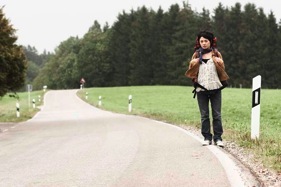The Red Spot (2008) DIRECTOR´S STATEMENT
This true story was my inspiration to tell the story of two people whose fates had been joined by a tragic accident. One person who had lost her family through the accident, and another who has borne the terrible secret of having accidentally killed a young family, ever since that fateful event. How did they go about their daily lives? What would happen if their paths were to cross again?
In the film, both documentary and fictional elements were joined together, and the stories of Aki, Johannes and Elias are the outcome. Aki Onodera, the young Japanese woman who had lost her family in an accident 18 years previously, travels to Germany to seek out traces of her past. There she encounters Johannes Weber, who in 18 years has never revealed his secret. For his son Elias, who has suffered under his father’s reticence since birth, riding a motorcycle at high speeds is the only way he can express emotional impact that this reticence has had. Out of nowhere, Aki breaks on the Weber family like a typhoon. In the center of a typhoon however, it is always calm and cloudless; as Aki pursues her goal with stoic composure the Weber family is pulled into a whirlwind.
The common thread of these stories is silence, or, more specifically the inability to speak with one another. The main protagonist, Aki, speaks only broken German, at best. Yet it is precisely by such meetings of different cultures that the possibility of a deeper human communication arises, as people free from their culturally conditioned habits are confronted with their existential being. In such situations nonverbal forms of communication, such as eye contact, small gestures and touch, play an important role. These nonverbal forms especially are used to a large extent as a means of filmic narration. The film uses atmospheric images that slowly flow into each other, allowing the viewer enough time to sense that which remains unsaid among the images.
Furthermore I find it a fascinating challenge to make Aki’s inner voyage visible through her exterior travels. In the middle of an idyllic South German landscape Aki encounters the visions and dreams that are anchored deep within herself. Among them, the image of a child swinging on a swing is an important motive; since her childhood Aki has constantly oscillated back and forth between two worlds – between her new family and her natural family, between the living and the dead.
Aki’s external journey is simultaneously a path to her innermost self, and thus correlates to the collective unconscious of all people. I hope that my film becomes this sort of Möbius strip.



The substance for this film came to me in 1998. I was working as an interpreter at the time, and accompanied a Japanese woman on an unusual excursion. The woman had a map upon which a spot on highway B17 was marked in red, and we took a taxi to the place. When we arrived at the spot, we found a small memorial stone at the side of the road. A Japanese family had been killed there in a tragic automobile accident in 1987. A six year old child was the only survivor. The Japanese woman whom I had accompanied was a relative of the family that was killed. She told me that the accident was a case of hit-and-run, and that the person who caused it had still not been identified. The child that lost its family through the accident was adopted and raised by relatives.